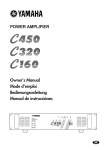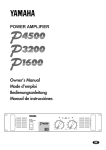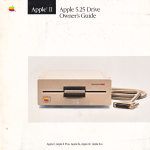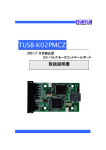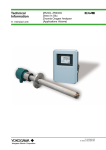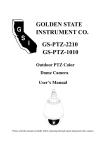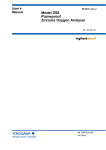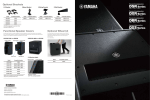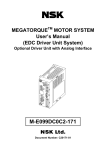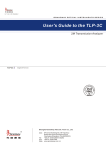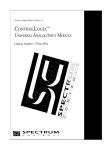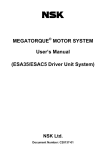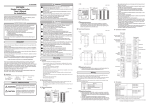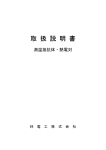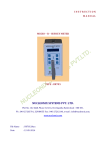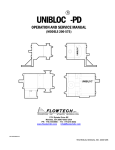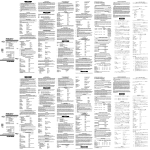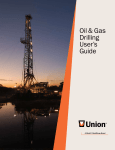Download RTD_TC_User`s_Manual MaS01E-1B
Transcript
USER’S MANUAL RESISTANCE THERMOMETER SENSORS & THERMOCOUPLES HAYASHIDENKO CO., LTD. Tokyo, JAPAN Table of Contents 1. BEFORE BEFORE YOU START 3 2.RESISTANCE THERMOMETER THERMOMETER SENSORS 6 2.1 General construction of Resistance Thermometer Sensors 6 2.2 Operating Temperature Range of RTD sensors 7 2.3 Tolerance of RTD sensors 7 3.THERMOCOUPLES 3.1 3.2 3.3 3.4 General construction of Thermocouples Limits of operating temperature Tolerance of thermocouples on temperature Extension and/or Compensating cables 4.WIRERING WIRERING 4.1 Wiring of RTD sensors 4.2 Wiring of thermocouples 4.3 Wiring with care 5. HOW TO HANDLE AND INSTALL SENSORS 5.1 Handling 5.2 Installation 8 8 9 11 12 13 13 13 13 14 14 14 6.HOW TO MEASURE TEMPERATURE CORECTLY 14 7.WARRANTY 15 7.1 Term of warranty 7.2 Range of warranty 7.3 Range of service 15 15 15 2 1. BEFORE YOU START Before you start to use temperature sensors, please read carefully this user’s manual and understand how to use temperature sensors correctly. If sensors are handled and/or treated with misuse, alteration, or abuse, it may cause the serious injuries or damages to personnel and objects. When you use temperature sensors, be sure to follow the instruction stated in this manual. The symbols and meanings used in this user’s manual are as follows. The below is the classification and explanation of a risk and its degrees occurred by a misuse, alteration, abuse, or abnormal handling. ! WARNING ! CAUTION “Warning” identifies the conditions and actions that may pose hazards such as death or serious injury to the user, when the sensor is misused, abused or abnormally handled. “Caution” identifies the conditions and actions that may damage the sensor being used, when it is misused, abused or abnormally handled. ! WARNING ● Installing a temperature sensor ・ Extension thermometer sensor) and compensation xtension lead wires for RTD(resistance RTD compensation cables cables for thermocouples should be connected to the terminals of the proper polarity on a measuring instrument. Do not connect to an AC power supply to prevent overheating and/or fire risks. ・ Do not handle a temperature sensor violently as it is a sensitive and fragile device. A human body may be damaged by dropping, etc. Moreover, it may cause breakage or short circuit inside the sensor and cause an inaccurate temperature measurement. ・ When install a temperature sensor at a hazardous place such as an explosion-proof area, precautions must be taken. The terminal head of a explosion-proof type temperature sensor is certified to use on condition that it should be placed at ambient temperatures between -20 degrees C to +40 degrees C. C Please carefully place the terminal head according to the regulations and/or rules on explosion-proof equipment after checking the ambient temperature of an installation place for safety. ・ The explosion-proof packing type cable gland is available in the drawing-in system of the external lead on a explosion-proof type sensor, and it is necessary to connect 3 an external lead wire by using the specified cable gland when using d2G4 explosion-proof sensors made by Hayashidenko. ● Maintenance The installation place of a temperature sensor may be mostly exposed extreme conditions such as high temperature and/or high pressure. It is very dangerous to immediately start a maintenance work in the process of an operation and just after the stop of an operation. A maintenance and replacement work should be performed after checking the stop of an operation and the temperature and pressure become almost the same as that of the ambient conditions. A sensor with a ceramic protecting tube may be broken by rapid heating or rapid cooling. Preheating should be generally needed for the tube. ! CAUTION ● Installing a sensor ・ When install a sensor with a terminal head, the temperature around the terminal head should be from room temperature to +60 degrees C and do not install it in a dusty, dirty, or wet environment. ・ If a part connecting inner leads of a sensor and outer extension lead wires (we call it “sleeve”) is exposed at high temperature, high humidity, and/or chemical agents and other, it may cause the degrade of filled epoxy resin inside and the failure of insulation resistance. ・ When a temperature sensor is fixed on machinery or equipment, generally it is fixed by using a screw or flange. When a screw is used, sealing tape or sealing agent should be wrapped on the screw for a JIS R (tapered) screw. And a gasket should be attached for a JIS G (parallel) screw. When it is installed by a flange, tighten the bolts equally attaching a specified gasket. If an air-tightness is required, carry out an air-tightness leak test after installing the sensor.(Figure 1) ・ A Mineral Insulated Metal sheathed RTD or TC sensor can be bent up to 5 times of the radius of the outer diameter of the metal sheath. But it may cause damage if it is bent less than 5 times of the radius and returned repeatedly. ・ And a platinum sensing resistor is enclosed in the tip of a MI RTD sensor. So never bend and give stress on the sensing part from the tip to 100mm long of the sensor (Figure 2). 4 Figure 1 Figure 2 Gasket Seal tape R≧5D 100mm Non bending φD MI Metal Sheath Do not apply excessive stress on lead wires when use a temperature sensor with lead wires. The connected part of the inner leads and the outer leads and/or the outer leads themselves may be damaged or broken by outer stress such as excessive pulling or bending. When attach a flexible tube to protect the outer leads, it may be broken the engaged part of the flexible tube by excessive stress. ● Storage ・Check the electric continuity and the insulation resistance of a temperature sensor before storage. ・ Do not store a sensor in a dusty, dirty or wet environment and store it an indoor and dry place. ・If a sensor is not used for a long period, store it in a PVC plastic bag, etc. with a drying agent. ● Disposal of a used sensor ・ Do not dispose of a sensor in a landfill. Treat the temperature sensor as an industrial waste when no longer usable. When it is difficult to throw away it as an industrial waste, make a contact with a company who can handle the industrial waste and get permission from a prefectural governor. ● The quality of dust dust and water proof of a terminal box ・ Sensors with terminal boxes that meet conditions as below are certified to dust and water proof. Temperature sensors mounted terminal boxes, type H2, H3, H4, H5, E6, or E7, and those that [water[water-proof] is stated in number codes. The state that the lid and conduit valve of a terminal box are accurately closed prevents the sensor from water and dust. ・ A water and dust proof test is to check under the JIS conditions whether or not 5 water, oil, and/or solid substances break into the inside of a terminal box sealed the conduit valve off. However, all of the products are not investigated in order to guarantee the quality of water and dust proof. Therefore, those products are CORRESPONDENT to the quality of water and dust proof and might not be able to be operated under any of your environment. ・ In case that the products are under tough conditions and unsuitable installations for water and dust proof, those cannot keep the quality of water and dust proof. ・ To keep the quality of water proof, we recommend reinstalling an O ring in a year due to the deterioration of the ring. 6 2 RESISTANCE THERMOMETER THERMOMETER SENSORS(JIS C 1604) 2.1 General construction of Resistance Thermometer Sensors A resistance Thermometer Sensor (often called as RTD: Resistance Temperature Detector) has various forms and constructions according to applications. The most typical construction is shown as Figure 1.1 and Figure 1.2 as below. Terminal Head Fixed Mounting (Flange) Terminal Block Inner leads Protecting Tube Pt Element 50 1A 2A A B b 2B 1B 1b Single 2b Double Fig. 1.1 The general construction of a RTD with a terminal head which is attached to a stainless steel protecting tube, flange and inserted a CRF sensing element A model CRF sensing resistor is an element used our CR (Ceramic wire-wound element) with stainless steel fin to fit into the inner wall of a protecting tube. Crimp-type A(RED) Terninal Lead wire MI Metal Sleeve Sheath(Ni) Ni leads B(WHITE) (40) Pt B(WHITEorBLACK) Magnesium MgO Element oxide Figure 1.2 General construction of a Mineral Insulated RTD sensor A MI(Mineral Insulated) metal sheathed RTD sensor is so manufactured that it has the construction of flexibility and the integrated structure by filling insulating 7 materials between the protecting tube and the internal connecting wires and sensing resistor. 2.2 2.2 Operating Temperature Range of RTD sensors sensors The operating temperature range of RTD sensors is different from the materials of protecting tube, the inner structure or style of sensors. Be sure to use the sensor within the temperature range specified at prearrangement. 2.3 Tolerance of RTD sensors sensors(JIS C 1604) Refer to the formula at Table 1-1. Table 1-1 Class Tolerance(Unit:℃) A ±(0.15+0.002|t|) B ±(0.3+0.005|t|) Remarks 1.|t| means the values of measured temperature (℃) regardless to the signs of + or -. 2. JPt 100Ω was abolished in revision of JIS in 1997 due to the conformity to IEC standard. 8 3 THERMOCOUPLES(JIS HERMOCOUPLES(JIS C 1602, 1605) 3.1 General construction of Thermocouples Terminal Head Terminal Protecting Tube Insulator + - 1 - + - + Single 2 Double Figure 2.1 General construction of Thermocouples Sleeve (Epoxi filling) Compensation lead Magnesium oxide TC wires Measuring Junction Figure 2.2 General construction of MI Metal Sheathed thermocouples Ungrounded Grounded Exposed Figure 2.3 Type of the measuring junction of MI thermocouple A thermocouple with a protecting tube is constructed with thermocouple bare wires, ceramic insulators, a terminal block and a terminal head as shown at Figure 2.1. Mineral insulated thermocouple is a thermocouple with such integrated construction that powdery inorganic insulator (for example, magnesium oxide; MgO) is filled up between metal sheath and thermocouple wires and sealed as shown at Figure 2.2. The MI thermocouple can be made 3(three) types of measuring junctions such as “Ungrounded”, “Grounded,” and “Exposed” junctions. The advantages of MI thermocouple are (1) thinness, (2)fast response, and (3)bendability---bending radius 9 shall be 5 times of the outer diameter of metal sheath as shown at Figure 2.3. 3.2 Limits of operating temperature Table2-1 Unit:℃ Diameter Nornal Elevated of Operating operating Symbol of Type element Temperatur Temperatur Wire e Limit e Limit (mm) (℃) (℃) B R S N K 0.5 1500 1700 0.5 1400 1600 0.65 1.0 1.6 2.3 3.2 0.65 1.0 1.6 2.3 3.2 0.65 850 950 1050 1100 1200 650 750 850 900 1000 450 900 1000 1100 1150 1250 850 950 1050 1100 1200 500 1.0 500 550 1.6 2.3 3.2 0.65 1.0 1.6 2.3 3.2 0.32 0.65 1.0 1.6 550 600 700 400 450 500 550 600 200 200 250 300 600 750 800 500 550 650 750 750 250 250 300 350 E J T Table2-2 Unit:℃ Sheath O.D. (mm) Sheath Material Sheath TC Type 1.0 1.6 3.2 A,B A,B 4.8 A 6.4 B A 8.0 B SK 650 750 800 900 800 1000 SE 650 750 800 900 800 900 750 750 SJ 450 650 350 350 ST 300 350 A: Austenitic stainless steel B: Corrosion and heat resistance super alloy * Normal operating temperature limit A 900 800 B 1050 900 750 350 Table 2-3 Unit:℃ Normal Elevated Operating Operating Material temp. limit Temp. Limit Iron 600 800 SUS304 750 850 Stainless Steel SUS316 850 950 SUS310S 900 1000 Titanium 400 500 Hastelloy C 1090 1250 Monel 500 600 Inconel 1000 1100 Sandvic P4 1000 1100 Khantal A1 1100 1300 Ceramic tube Type0(PT0) 1600 1850 Ceramic tube Type1(PT1) 1500 1550 Ceramic tube Type2(Pt2) 1400 1550 Si3C4 tube 1400 1600 Table 2-4 Unit:℃ Normal operating Temperature Limit Material of Lining & Tube Glass lining 200 FEP(Teflon) Tube 180 The limits of normal operating temperature and elevated operating temperature are given in JIS C 1602-1995 “Thermocouples” and JIS C 1605-1995 “Metal Sheathed Thermocouples”. 10 “Normal operating temperature limit” means the limit of temperature within which thermocouples can be continuously used in the air. “Elevated operating temperature limit” means at which thermocouples can be used for a short time in case of unavoidable needs. Regarding the normal operating temperature and the elevated operating temperature, refer to Table 2-1 for thermocouples, Table 2-2 for Metal Sheathed Thermocouples and Refer to Table 2-3 for the normal operating temperature of protecting tubes. Moreover refer to Table 2-4 for the normal operating temperature of lining and Teflon tube. 11 3.3 Tolerances of thermocouples on temperature Type B R, S N K E J T Temperature range Torerance Temperature range Torerance Former grade* Temperature range Torerance Temperature range Torerance Former grade* Temperature range Torerance Temperature range Torerance Former grade* Temperature range Torerance Temperature range Torerance Former grade* Temperature range Torerance Temperature range Torerance Former grade* Temperature range Torerance Temperature range Torerance Former grade* Temperature range Torerance Temperature range Torerance Former grade* Table 3 Classification by tolerance(2) Class 1 Class 2 Class 3 ─ ─ 600℃≦T<800℃ ─ ─ ±4℃ ─ 600℃≦T<1700℃ 800℃≦T<1700℃ ─ ±0.0025・|t| ±0.005・|t| ─ ─ Grade 0.5 0℃≦T<1100℃(3) 0℃≦T<+600℃ ─ ±1℃ ±1.5℃ ─ ─ 600℃≦T<1600℃ ─ ─ ±0.0025・|t| ─ ─ Grade 0.25 ─ -40℃≦T<+375℃ -40℃≦T<+333℃ -167℃≦T<+40℃ ±1.5℃ ±2.5℃ ±2.5℃ 375℃≦T<1000℃ 333℃≦T<1200℃ -200℃≦T<-167℃ ±0.004・|t| 0.0075・|t| 0.015・|t| ─ ─ ─ -40℃≦T<+375℃ -40℃≦T<+333℃ -167℃≦T<+40℃ ±1.5℃ ±2.5℃ ±2.5℃ 375℃≦T<1000℃ 333℃≦T<1200℃ -200℃≦T<-167℃ ±0.004・|t| 0.0075・|t| 0.015・|t| Grade 0.4 Grade 0.75 Grade 1.5 -40℃≦T<+375℃ -40℃≦T<+333℃ -167℃≦T<+40℃ ±1.5℃ ±2.5℃ ±2.5℃ 375℃≦T<800℃ 333℃≦T<900℃ -200℃≦T<-167℃ ±0.004・|t| 0.0075・|t| 0.015・|t| Grade 0.4 Grade 0.75 Grade 1.5 -40℃≦T<+375℃ -40℃≦T<+333℃ ─ ±1.5℃ ±2.5℃ ─ 375℃≦T<750℃ 333℃≦T<750℃ ─ ±0.004・|t| 0.0075・|t| ─ Grade 0.4 Grade 0.75 ─ -40℃≦T<+125℃ -40℃≦T<+133℃ -67℃≦T<+40℃ ±0.5℃ ±1℃ ±1℃ 125℃≦T<350℃ 133℃≦T<350℃ -200℃≦T<-67℃ ±0.004・|t| 0.0075・|t| 0.015・|t| Grade 0.4 Grade 0.75 Grade 1.5 Tolerance means allowable maximum of the remainder of the temperature converted Note(2) from thermoelectromotive force using the table of the reference thermoelectromotive force substracted by the temperature of measuring junction. Note(3) Tolerance class 1 of type R and S thermocouples is applicable to standard thermocouples. Re 1. |t|means the value of measured temperature (℃) regardless to the sign of + or -. Re 2. The mark * means informative reference. The tolerances are classified in each type of thermocouples as shown in Table 3. 12 3.4 Extension and/or Compensating cables Extension and/or compensating cable is identified with color according to the type of thermocouples and have nearly the same thermoelectromotive force characteristic as the thermocouple which is to be used in combination. Tolerance of compensating cable is determined as Table 4 according to the temperature of connecting junction with thermocouple. When wiring thermocouples, be sure to use the proper compensating cables. If the unproper cable such as the cable for a different type of thermocouple or copper lead wires are used, it will generate the unproper EMF and will not be able to expect the accurate measurement. Be sure to keep the temperature of compensating junction properly at connecting point with thermocouple and compensating cable. Former Synb symbol Type of TC ol (refere nce) B R S N BC RCA RCB SCA SCB BX J Color (Class2) Gray Gray RX Orange Black SX SX-G ─ ±60 0~+200℃ SX-H ±60 ±100 -25~+200℃ ─ ±100 0~+150℃ KCA ─ ─ ±100 0~+150℃ Blue KCB WX ─ ±100 0~+150℃ KCC VX ─ ±100 0~+100℃ EX EX ±120 ±200 -25~+200℃ Yellow 0~150℃ RX-H 0~+100℃ -25~+200℃ Black +3 -7 0~+200℃ ±30 ±100 JX ─ ±60 ±60 JX ─ ─ KX Purple BX-G ─ KX Amethyst Temperature of compensating junction(℃) RX-G ─ Green Tolerance (℃) 0~+100℃ ─ ─ Symbol ±30 NC Pink JIISC1610-1981(旧JIS) ─ NX K E Color (Class1) Table 4 Tolerance(μV) Temperature of compensatin Class1 Class2 g junction(℃ ─ ─ 0~+100℃ ±85 ±140 -25~+200℃ KX-G KX-H KX-GS KX-HS WX-G WX-H VX-G TX TX Brown Brown ±30 ±60 -25~+100℃ ±1.5 -20~150℃ ±3.0 ±2.5 -20~100℃ EX-G EX-H JX-G ±2.5 JX-H TX-G T ±2.5 TX-H TX-GS TX-HS -20~150℃ ±2.0 ±1.0 * Hayashidenko has the extension cables corresponding to JIS C 1610-1995(former JIS) as standard stock for the time being. * The goods corresponding to new JIS C 1610-1995 are made-to-order. * Color of porality: +(plus) the same color with overall, -(minus) White for Class 1. 13 4 WIRING 4.1 Wiring of resistance thermometer sensors The wiring system of resistance thermometer sensors includes 2-wire conducting, 3-wire conducting and 4-wire conducting system as shown at Figure 3.1, The terminal A of the RTD should be connected to the terminal A of the measuring device. The terminal B of the RTD should be connected to the terminal B of the measuring device. The terminal b of the RTD should be connected to the terminal B, b or C of the measuring device(The name of the terminal may be different from the manufactures).You may connect the terminal B of the RTD to the terminal b(B or C) of the measuring device to whichever. Be sure to tighten the screw of the terminals and use care for short by dust, dirt or foreign materials. A S S B 2 wire system Not expect accrate measurment due to adding resistance of leads A A B B A B B 3 wire system S 4 wire system Most general for industrial use Suitable to accurate measurment by measuring potential difference using constant current Figure 3.1 Wiring system 4.2 Wiring of Thermocouples Thermocouples should be connected to the terminals of a measuring equipment by using special compensating cables. Check the polarity of plus(+) and minus(-) and connect to the proper terminal, and be sure to tighten the screw of the terminals. And connect the cables carefully not to occur short-curcuiting by dust, dirt or foreign materials. 4.3 4.3 Wiring with care When wiring the sensor to a measuring instrument, be sure to take care as the type of extension lead wires are perfectly different from RTD and thermocouples. Choose the proper materials for overall and lead wires. Connect the terminals of sensor to the input terminals of the measuring instrument. Be sure to wire the cable of sensor apart from power line and power supply. 14 5 HOW TO HANDLE AND INSTALL SENSORS 5.1 Handling ・When it seems that the sensor fail to operate properly, do not decompose the sensor and contact us first. ・ Do not apply the sensor with vibration and shock in handling or transportation. Especially handle the sensor with ceramic protecting tube with special care as it is easily broken. ・ The minimum bending radius of metal sheathed thermocouple shall be 5 times of the outer diameter of metal sheath. The minimum bending length of metal sheathed RTD sensor shall be more than 100 mm from the tip of the sensor. 5.2. Installation ・ Check the polarity of the terminals and connect the sensor properly. ・ Keep the temperature of terminal head and sleeve at 60 degrees C or below. Install the sensor to the place without water and moisture. ・ To prevent the influence of noise, install the lead wire apart from the power line with high voltage and high current. Do not install the compensating wire parallel to or together with the power line. The wire with shield could expect the efficiency of preventing the electric noise. ・ Install the compensating wire apart from the noise source such as high frequency wave and microwave. ・ Be sure to keep properly the temperature of compensating junction with thermocouple(see Table 2-2). If it will exceed the temperature shown, measuring error would be greater than that. 6 HOW TO MEASURE THE TEMPERATURE CORRECTLY The measuring junction of a thermocouple and the sensing resistor of a RTD should be needed to equal thermally to the measuring object. So it is essential to have the insertion length sufficiently. The insertion length may differ depending on the measuring condition but the following shows the insertion length at the magnify of the outer diameter of protecting tube as a guide. Wall of furnese 10 times 15 times MI RTD 10 times 15 times TC M ( eta l) 15 to 20 times TC (Nonmeta l) 15 to 20 times Insertion Length inside of furnese Erro of temperature Protecling Tube MI RTD O.D.of Still air Differeuce of temperation Still water Type 15 7 WARRANTY 7.1 Term of warranty 1(one) year from the date of shipment at Hayashidenko 7.2 Range of warranty Warranty is limited to the fault of the products by the cause on Hayashidenko. If it is clear that the failure is occurred by our fault, we will repair or exchange the products under our responsibility. But we will except from the guarantee if it corresponds to the following items. ① If it based on unsuitable condition, environment, handling, use, etc. except having been checked by our catalog, or the specifications written separately ② If the cause of failure is based on reasons other than manufacturers ③ The failure based on decomposition, reconstruction, repair, inspection, etc. by other company without our permission. ④ The failure based on the use of the goods without original method to use ⑤ The failure based on the reason which was not able to be foreseen with the level of the science and technology at the shipment from our company ⑥In addition, the failure based on causes which are not responsible for our company, such as accident and disaster "A guarantee" means the guarantee only for the goods supplied. The guarantee of the damage induced by failure of the goods will be taken as exemption from responsibility. 7.3 Range of service Please notice that the following service like dispatch of a technician is not included the price of sensors. 1. Training and/or joint servey or inspection on site 2. Maintenance and adjustment and repair 3. Instruction and education for sensor technique 4. Special test and inspection at the condition specified by customer Please consult Hayashidenko or our distributors separately when the above services are required. * The manual is subjected to change without notice. 16 HAYASHIDENKO CO., LTD ISO9001 accredited and ISO14001 accredited URL : http://www.hayashidenko.co.jp Head office & Tokyo Sales office: office: 6-5-5, Honkomagome, Bunkyo-Ku, Tokyo 113-0021 Japan TEL03-3945-3151 FAX03-3945-3130 Osaka Sales Office: Hanahara No. 8 Bld, 6-8-8 Nisi-Nakajima, Yodogawa-Ku, Osaka 532-0011 TEL06-6885-4801 FAX06-6885-4825 Shizuoka Shizu oka Sales Office: 16-3, Ejiridai-Machi Shimizu-Ku, Shizuoka TEL0543-64-9460 FAX0543-67-4046 Issued in June, 2005 MaS01E-1B 17 18


















